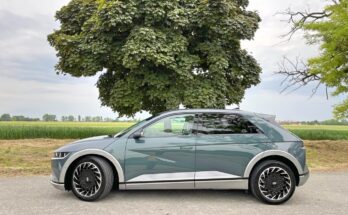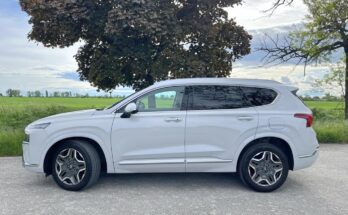For the editorial test, after the modernized "twenty", I got another representative of this Korean car company, which is noticeably more prominent. The tested car for last week was the new generation Hyundai Santa Fe.
Santa Fe and its fourth generation appealed to me some time before the actual editorial test. So I had a lot of "peeks" on the car ahead and I was really looking forward to the test. The general awareness of the current rise of the Hyundai car company is irrefutable, and the question is whether the current fourth generation of this model will support this trend.

Pleasant exterior
The exterior appearance of the car will certainly appeal to you at first glance, mainly in the context of the historically not so attractive design of the car company's cars. However, the new generation Santa Fe looks very handsome and confident. Optically, it easily follows the Kona and Nexo models, which are also quite short in the brand's portfolio. Compared to the previous generation, this new one has a significantly more dynamic and modern impression.
The new Santa Fe very elegantly managed to suppress its large external dimensions. The front part has a concept of split lights, which greatly help to divide the large mass of the car. Personally, I'm not a fan of split lamps, but here I have to admit that Hyundai has done this in a very elegant and balanced way. The proportions and sizes of the separate lights simply match each other, and the shape of the "upper" daytime running lights is very cool, slightly futuristic. Of course, a large car must not miss a bulky grill on the front grille, and yes, the Santa Fe has that too.
The side section adds robustness to the car, while the distinctive side line gives it a certain dynamism. The proportion between the solid and glazed part of the side part of the car is also pleasant. The rear is dominated by horizontally oriented tail lamps and a pair of honest exhaust tips.
The Hyundai Santa Fe of the fourth generation simply did well in terms of external appearance, and it is hard to fault it for anything here.

Spacious interior
Premium Luxury is the name of the level of equipment that the tested car had and, as the name itself suggests, it was very richly equipped. The color of the interior was tuned to a beige shade, which, together with the slightly ashy gray ceiling and pillars, looked really interesting and original. Of the other offered gray or black interior variants, this seems to me to be the most interesting and original choice.
A large interior space is logically expected due to the dimensions of the car. However, the richly dimensioned leather quilted seats, which are all heated and also ventilated in the front positions, deserve praise. The rear bench allows for horizontal movement and the possibility of folding the backrest itself. A very practical matter that will simply make long journeys more pleasant.
The fourth generation has recently dropped the double body size and has chosen a golden middle ground in terms of its size. However, the option of a seven-digit specification remained, and the tested car also had this option. These places will clearly belong to the smallest and bravest members of the family, because there is simply not the most space and access is also not so easy. In addition, the third row of seats entails certain spatial limitations in the volume of the trunk, but it still has a pleasant volume of 547 liters.
But let's go ahead, here is a strictly horizontally divided dashboard with a pair of effective cut-outs, which goes all the way to the side panels of the doors. In addition, the horizontality of the dashboard is supported by the air conditioning vents themselves. The clear dashboard is then dominated by the eight-inch on-board infotainment display. Its control is classic, known from previously tested cars of the brand. Here I would only lobby for better graphics of displayed data. The middle part of the dashboard then belongs to the controls for the automatic climate control or the controls for heating the seats and the steering wheel. However, they are very pleasantly turned off and on automatically in the context of the desired and current temperature in the car. The steering wheel certainly deserves praise, its multi-functionality has its own logic and pleasant control. The tested car had a digital instrument cluster, or rather its larger central part. Speed and vehicle related information are displayed here. This digital part subsequently changes graphically with the selected driving mode. On the sides of this digital display are the classic tachometer, fuel gauge and engine temperature indicators.
The treatment of the entire interior of the car and the processing of not only the dashboard is at a high level, and after praising the exterior itself, I have to praise it here as well.
It is also worth mentioning the new assistants that the Santa Fe now has in the interior. This is a system that monitors the surroundings of the car and makes sure that we do not step directly under the wheels of a passing car. We also have an assistant who monitors the space in the back seats. If the driver leaves the car, locks it, and there is a passenger in the back seat, the car will alert him of this fact with the horn.

Motorization
The Santa Fe boasts a four-cylinder engine in its technical specifications. From the petrol 2.4 GDi, through the 2.0 CRDi in a dual power version to the tested 2.2 CRDi. However, the offer is currently only 2.0 CRDi (110 kW) and 2.2 CRDi (147 kW).
As I already mentioned, I personally tested a four-cylinder diesel unit with a volume of 2.2 liters. It was developed to a power of 147 kW with a torque of 440 Nm. These quite potent values are of course limited by the considerable weight of the car and subsequently by the all-wheel drive. Despite these logical "limitations", I have to admit that the tested Santa Fe is definitely not a lazy person. The starts themselves may seem a little more lukewarm, but otherwise I have to admit that this engine pleasantly surprised me with its flexibility. As for consumption, I was able to reach a value of 7.8 l / 100 km, which is definitely not a bad figure for a car of this specification.
The Santa Fe chassis has classic springs with adaptive shock absorbers that respond to the selected driving mode. There are four of them available, from eco, to comfort, to sport and smart modes. I used the comfort mode the most, it simply fits the car best. The very well soundproofed interior in connection with this setting of the chassis, steering and transmission makes the ride very smooth, an adequate impression of the whole car. I used the sports mode more in situations when overtaking, the chassis stiffens, the steering stiffens and the transmission holds the individual gears much longer. And this location is surprisingly not alien to Santa Fe at all. The stiffer steering is quite noticeable in the sport mode, because even in the comfort mode you struggle with the steering wheel, the steering is not significantly overpowered, and that is only good.
HTRAC is a system that at Hyundai takes care of the distribution of power between the individual wheels. This distribution of the tested car depends on the selected driving mode, and then on the current state of the road surface.

In conclusion
The fourth generation Santa Fe is another successful link in the chain of cars from the Hyundai brand portfolio. Currently, it can offer you a very elegant car, with a slightly sporty character, with a spacious and well-crafted interior. All this for a fairly reasonable purchase price. The car tested by me with a 2.2 CRDi engine, eight-speed automatic and PREMIUM LUXURY equipment starts at CZK 1,289,990 including VAT.







































